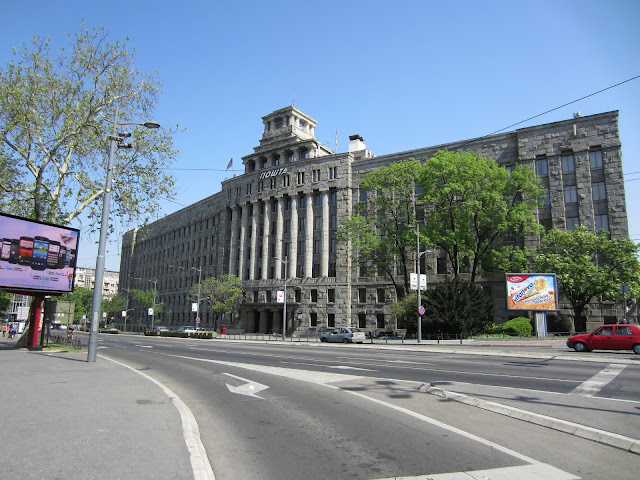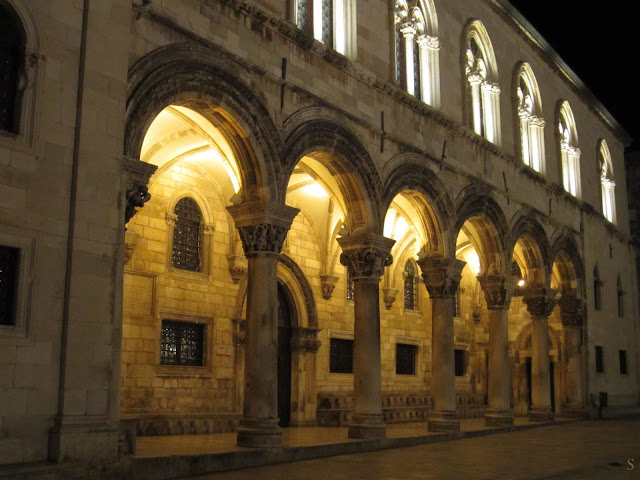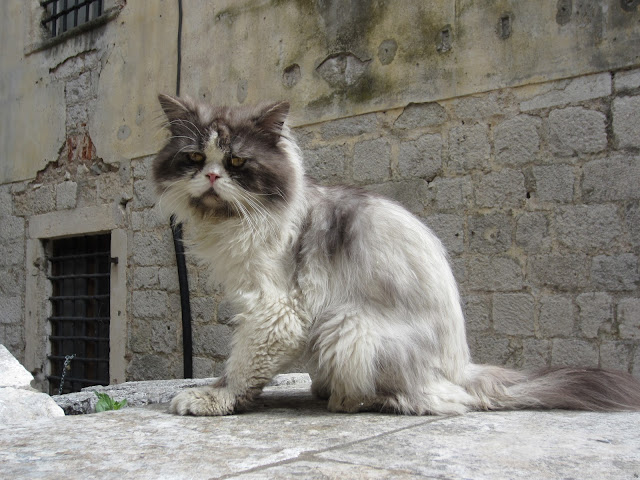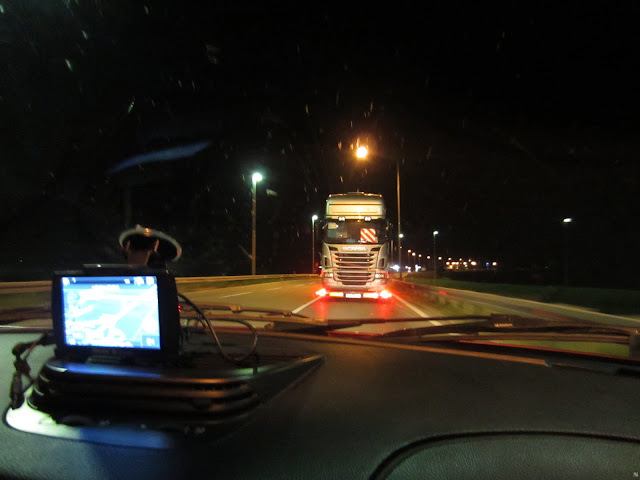Where: Croatia & Montenegro
When: 1-6 May 2013
The short version: 6 days, 2238 kilometers, 3 countries, 7 destinations, 1246 photos...
| A Balkan Roadtrip |
But if you want details, read on! ;)
Before you look at the scroll and see how far the bottom end is, here are the places we visited:
- Zagreb, Croatia
- Plitvice Lakes National Park, Croatia
- Split, Croatia
- Dubrovnik, Croatia
- Kotor, Montenegro
- Budva, Montenegro
- Podgorica, Montenegro
If you're interested in a particular one, just click on it. But if you want to know what happened in between, keep reading.
This roadtrip was inspired by a friend of mine, who mentioned she was going on a trip to Croatia during our May holidays. I wanted to go with but the bus was already full so I had to figure another way out. And there it was - the solution was parked outside the house.
We drove off in the late morning of May 1, crossing the first border (Bulgarian-Serbian) without any difficulties. We didn't need passports, our IDs worked fine. (They did in all three countries.)
At the first gas station, I learned my first words in Serbian. "Dobur dan" is the way they say good afternoon, which is really close to ours (Bulgarian) - "dobur den". It's also how they say it in Croatian - convinient, I know. One more important word - "hvala" meaning "thanks" in both languages.
I didn't get to practice my English much. Our languages are so close that it was easier to speak Bulgarian most of the time. They spoke Serbian/Croatian, we spoke Bulgarian and we understood each other pretty well.
What's interesting about Serbian is that it uses both Cyrillic and Latin alphabets. Their Constitution recognizes the Cyrillic script as official but there are no regulations that make it obligatory to use. On the contrary, Serbs are free to use whichever they choose in almost every aspect of life.
With the vocabulary basics covered, we headed to Beograd through a series of consecutively numbered tunnels. We spent an hour or so in the Serbian capital, just enough for a quick walk and an ice-cream. The best part - there was no parking fee. Turns out May 1 is an official holiday in Serbia as well (International Workers' Day or Labour Day).
We saw just a little of the city. There was the National Assembly (Народна скупштина / Narodna skupština):
 |
| National Assembly (Народна скупштина / Narodna skupština) |
- former Parliament of Serbia and Montenegro (until 2006 when Montenegro became independent). It is the legislature of Serbia now.
St. Mark's Church (Црква Светог Марка / Crkva Svetog Marka):
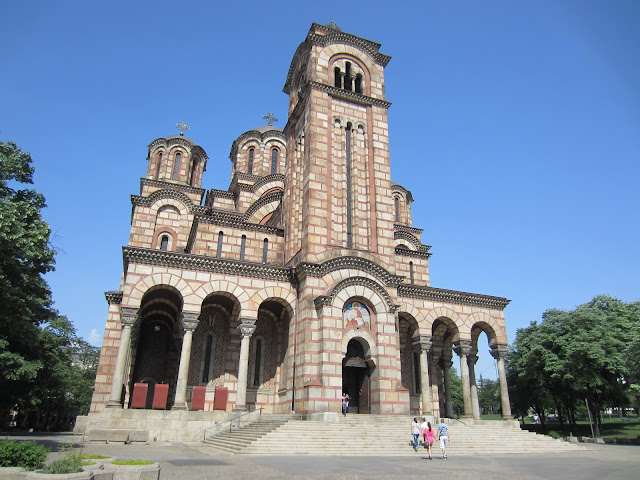 |
St. Mark's Church (Црква Светог Марка / Crkva Svetog Marka) |
An orthodox church (one of the largest), located in TaЕЎmajdan park, where we had that ice-cream. There was a guy in front of the church with a small dog who suddenly started calling her name in panic. He thought he'd lost her when she was actually at his feet. That was funny. He turned out really nice, though. He appologized, offered to take a picture of us with the church and even called us "brothers" when we admitted we were from Bulgaria.
Next - a post office:
I just love the way the write "post" - "пошта".
Beograd wasn't a part of the roadtrip's initial plan so we promised to visit another time for more sightseeing and left for Zagreb. The roads were good, in Croatia even better than in Serbia, which should explain the trippled highway toll fee. In both countries, the highway payment system was with toll booths. You get a ticket when you take the highway and pay at the exit, depending on the distance you've travelled. A note for those using LPG. Once we crossed the Serbian-Croatian border, there was no LPG at the gas stations almost all the way to Zagreb.
There were also lots of animals crossing in all three countries. We saw a couple turtles (no animals were harmed in the making of this roadtrip... not by us anyway). There was also this bird that we saw flying away from a rock holding a snake with its toes. Nature.
Some other things to know about Croatia. It is not yet in the European Union, at least not until July 1 and the official currency is Kuna. Even though they seem to accept Euro in most tourist destinations, it's good to have local money. 1 Euro is like 7.5 kuni.
Once in Zagreb, we found our apartment quickly but we had to wait a couple of hours to check in and spent those at the Croatian National Theatre in Zagreb (Hrvatsko narodno kazaliЕЎte u Zagrebu):
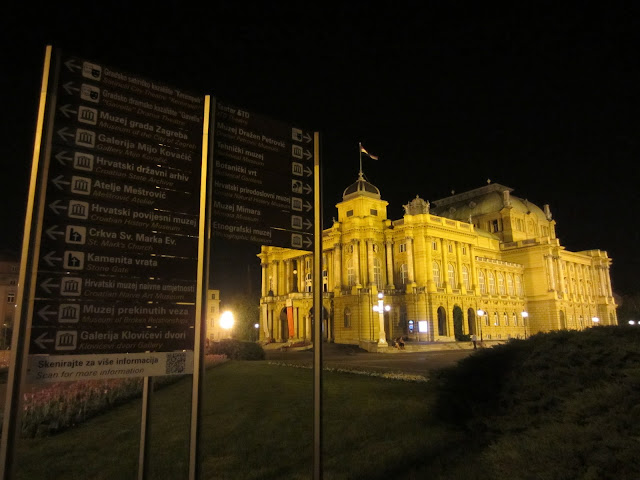 |
| Croatian National Theatre in Zagreb (Hrvatsko narodno kazaliЕЎte u Zagrebu) |
It's a beautiful building (that kind of reminds of our National Theatre) and there were a lot of young people gathered around it. I guess, there's something about theatres, because lots of people bunch up around ours as well.
Opposite the theatre was the Museum of Arts and Crafts:
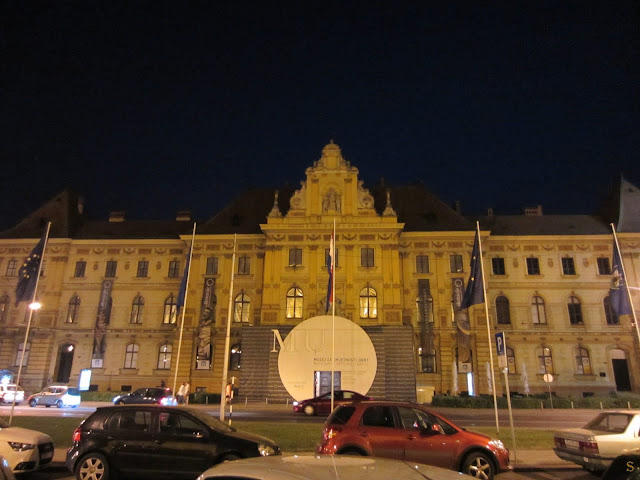 |
| Museum of Arts and Crafts |
Two hours later, we left our luggage at the apartment and headed to the Old City (Gornji grad). Just below it is Ban Jelačić Square (Trg bana Josipa Jelačića or Trg bana Jelačića):
 |
| Ban Jelačić Square (Trg bana Josipa Jelačića or Trg bana Jelačića) |
It's the central square of Zagreb, named after Count Josip Jelačić of Bužim, who was the Ban of Croatia in the 19th century, remembered for his military campaigns during the Revolutions of 1848 and for his abolition of serfdom in Croatia. There's a statue of him on a horse in the middle of the square.
Up a sloping hill we found ourselves on a cobblestone street in the Old City. It led us to Krvavi most:
| Krvavi most |
The literal translation of the name is "Bloody Bridge". Why "bridge" you ask? It used to be one (now a street) that connected the villages Gradec and Kaptol (which later united into Zagreb). The relations between the citizens of the two villages were tense and often led to conflicts on that bridge. Hence, the name.
Those two towers at the background belong to the Zagreb Cathedral. We got to it at some point but first, we found the Stone Gate (Kamenita vrata):
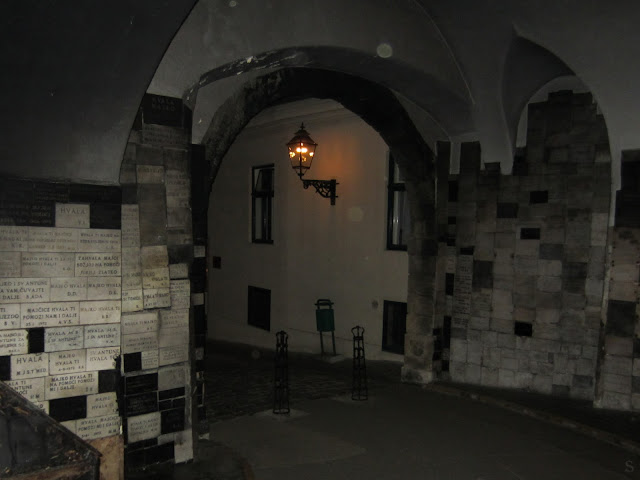 |
| The Stone Gate (Kamenita vrata) |
It's the east gate to the Old City and is the only gate still preserved. There's a church on the inside with an icon of Saint Mary, surrounded by thank you notes (the stone tiles visible in the picture).
Further up, we found St. Mark's Church, located on St. Mark's square.
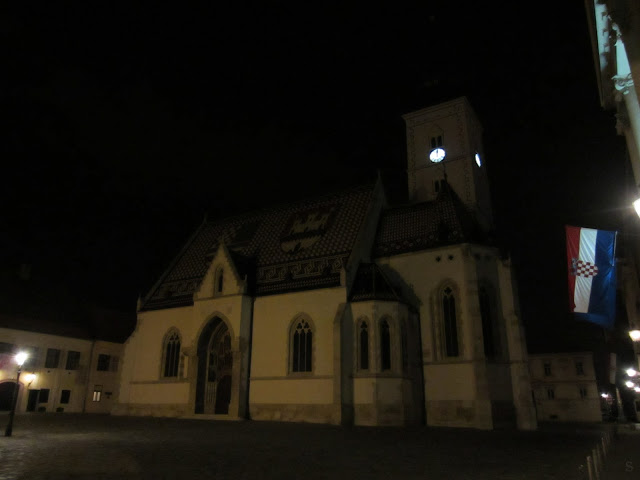 |
| St. Mark's Church (Crkva sv. Marka) |
It's the parish church of old Zagreb.
One of the most popular streets in the Croatian capital is Tkalčićeva Street:
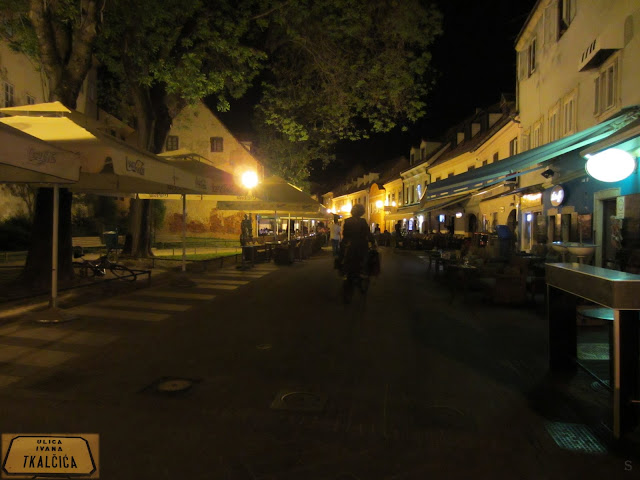 |
| Tkalčićeva Street (Ulica Ivana Tkalčića) |
With its galleries and cafes on both sides, it's the place to go out in the summer.
As promised, we reached the Zagreb Cathedral:
 |
| Zagreb Cathedral (ZagrebaДЌka katedrala) |
It's the tallest building in Croatia, Roman Catholic. One of its towers is 1 meter taller than the other (104 & 105 m). In the 15th century, fortification walls were built around, as protection from the Ottoman invasion, some of which are still intact. In 1880 there was an earthquake that caused great damage to the cathedral which led to its restoration in Neo-Gothic style by an Austrian architect. During the earthquake, the clock on one of the fort walls stopped (along with many other clocks in the city) and hasn't worked since, so it shows the exact time of the calamity:
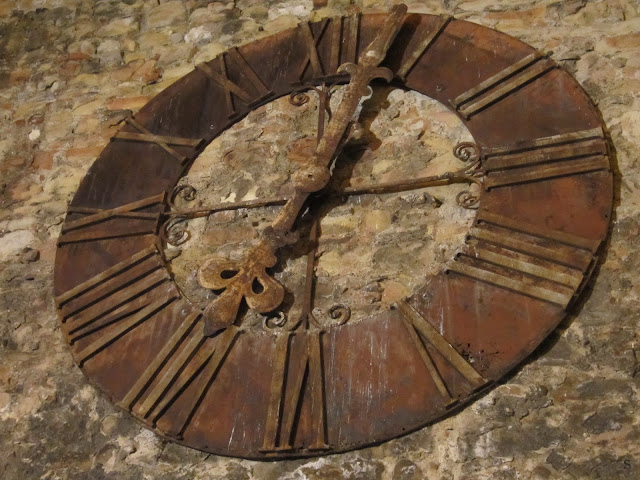 |
| A clock in Zagreb |
Looking at that clock reminded us to take a peek at our watches and we realised it was 2 am. It was time to end our walk and we headed back to the apartment. We were half way there when it started pouring. The street had a bunch of traffic lights, (one of which we used as a indicator for our building) and we thought we were no more than two away from the place so we ran, hiding under building entrances' eaves. But when we reached the second traffic light, it turned out it wasn't ours. The same happened with the next one. Needless to say, we were soaked by the time we finally made it. The lesson here: choose something unique to orient you.
The apartment itself turned out quite impressive. It was a combination of retro & modern style with great character. The part I loved most:
 |
| Our apartment in Zagreb |
In the morning, we had some trouble with parking. Since we were close to the center, we were in one of the paid parking zones so we had to either get a ticket or send a text. The text message was not an option since the numbers are for local mobile networks only, so we had to get up really early to find a ticket parking machine.
On a brighter note, that gave me time to see more of the city. I had my morning coffee at the National Theatre (I loved the place)
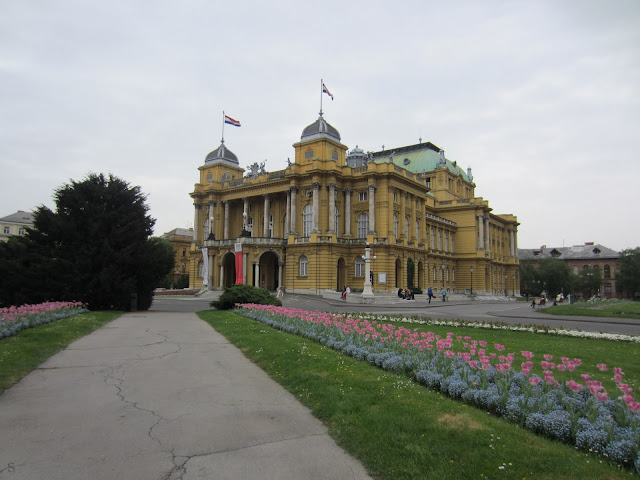 |
| Croatian National Theatre in Zagreb (Hrvatsko narodno kazaliЕЎte u Zagrebu) in daylight |
and followed the map we found at the apartment to some sights outside the Old City. First, I came across the Ethnographic Museum:
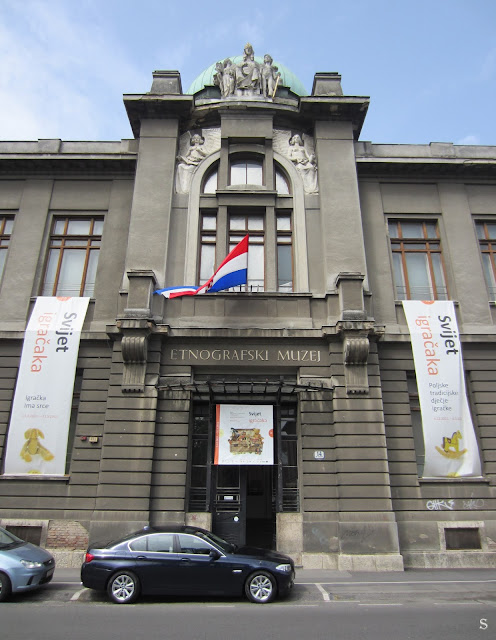 |
| Ethnographic Museum (Etnografski Muzej) |
I didn't get in, but later I read there are plenty of collections in there, preserving the etnographic heritage of Croatia - of agricultural obejcts, of fishing and hunting ones, transportation and more.
The Zagreb Botanical Garden:
 |
| Zagreb Botanical Garden |
It's part of the Faculty of Science of the University of Zagreb.
Following the tourist route on the map, I reached the Zagreb Central Station (ZagrebaДЌki Glavni kolodvor) - the largest railway station in Croatia:
 |
| Zagreb Cenral Station (ZagrebaДЌki Glavni kolodvor) |
We didn't get to use a train in Croatia so I have no idea of the system but be sure to read the small letters on the ticket in case you need to validate it before getting on the train. The last thing you want is to be fined for such a formality (the way we were in Italy).
One thing I noticed about Zagreb - there's no subway. The public transport is mainly represented by trams but there are also buses.
Across the Central Station, a monument of King Tomislav rises on a square of the same name.
 |
| King Tomislav |
He was the ruler of Croatia between 910 and 928 and is known as the founder of the first united Croatian state.
North of the square I came across the Art Pavilion (UmjetniДЌki paviljon):
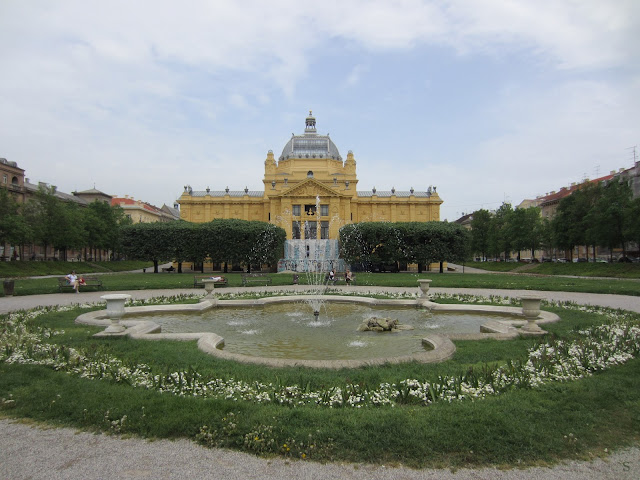 |
| Art Pavilion in Zagreb (UmjetniДЌki paviljon u Zagrebu) |
It's an art gallery, the oldest in Southeast Europe, built specifically for the purpose of exhibiting art.
On the other side of the Pavilion is the Strossmayer Gallery of Old Masters (Strossmayerova Galerija Starih Majstora):
 |
| Strossmayer Gallery of Old Masters (Strossmayerova Galerija Starih Majstora) |
A fine art museum, exhibiting the collection donated to the city by Bishop Josip Juraj Strossmayer (the works of European painters from 14th-19th century), part of the Croatian Academy of Sciences and Arts.
The gallery is located at Nikola Šubić Zrinski square and park, known as Zrinjevac. Busts of significant Croatian people are spread around the park:
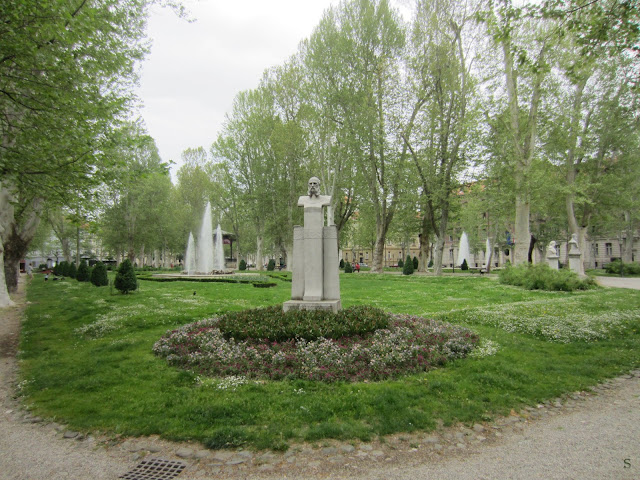 |
| Zrinjevac |
Zrinjevac is part of the so called Green Horseshoe or Lenuci's Horseshoe, named after its creator, an urban planner Lenuci. It's a framework of parks and the buildings in them in the central part of Zagreb, which includes 8 squares and is in the shape of a U (which explains the name). Zrinjevac is on one of the tips of the U and the National Theatre is on the other. The Botanical Garden is somewhere at the base.
Speaking of green, here's an eco-friendly way to pick up trash:
 |
| Picking trash in Zagreb |
On one side of the park was the Modern Gallery (Moderna galerija):
 |
| Modern Gallery (Moderna galerija) |
A museum that holds the most important and comprehensive collection of paintings and sculptures by 19th and 20th century Croatian artists.
I was trying to take a picture of myself with the surrounding when I got a phone call from my companion, whom I'd left in the apartment to get more sleep. And by left I mean locked. As you can imagine, I had to hurry back. On the way, I passed by this church, which I don't know the name of:
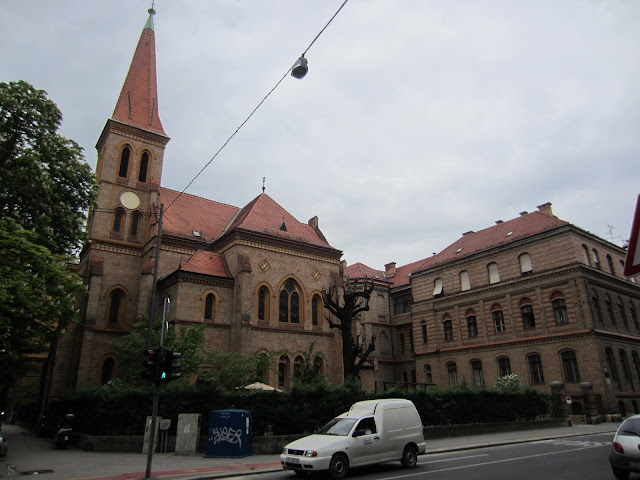 |
| Church in Zagreb |
If anyone asks, I didn't stop specifically to take that picture. I mean, I was in a hurry with the apartment keys in my hand... but took it while waiting to cross the street. That's the version I'm sticking with.
I did get to the apartment at some point, we checked out and took a little more time to go sightseeing. Which took us to Mimara Museum - the only one we saw on the inside as well as the outside.
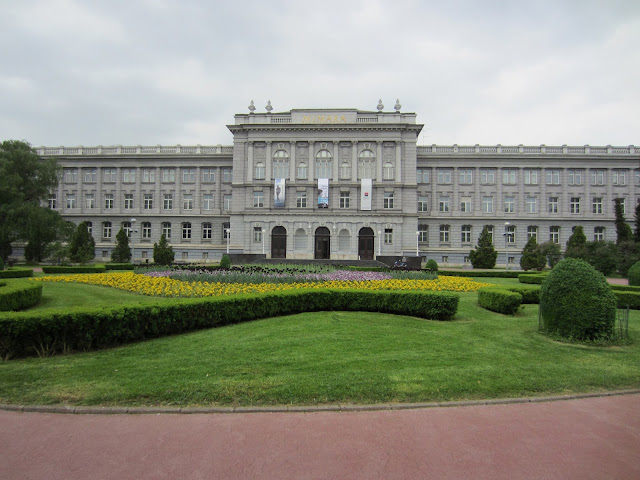 |
| Mimara Museum |
It's a 3-storey art museum (though part of the building is a high-school), housing the collection by Wiltrud and Ante Topić Mimara. The exibit includes works by Velazquez, Caravaggio, Manet, Renoir and more.
There's a wifi audioguide (for which I only needed my smartphone) that explains most of the exibited objects. A clever system.
Another museum I wanted to visit was the Museum of Broken Relationships (Muzej prekunitih veza), but we didn't have time to. Oh well, there's always next time.
Our next stop was at the Plitvice Lakes National Park (Nacionalni park PlitviДЌka jezera).
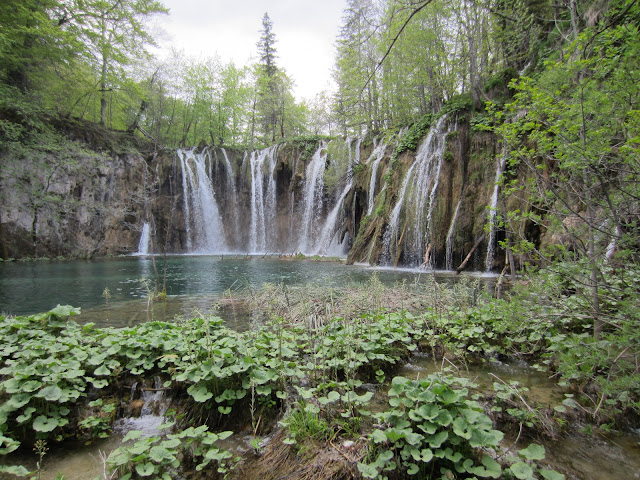 |
| Plitvice Lakes National Park (Nacionalni park PlitviДЌka jezera) |
The park comprises of series of lakes and waterfalls, laid in cascades.
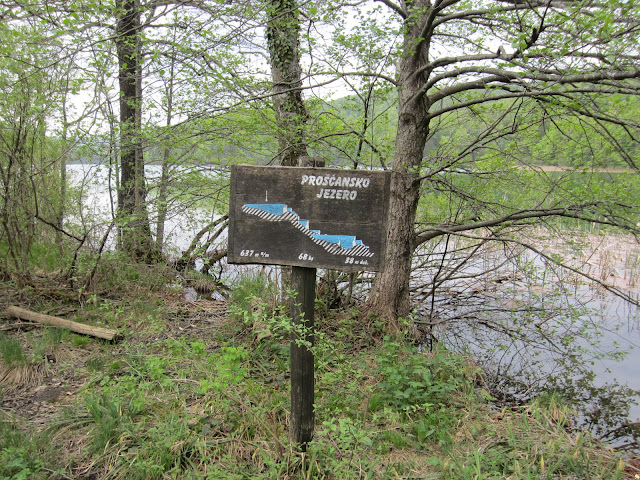 |
| Plitvice Lakes National Park (Nacionalni park PlitviДЌka jezera) |
It's the largest in Croatia and really beautiful. I hadn't seen so many waterfalls in one place.
There were several routs. The lady that sold us the tickets recommended route E. A bus took us to the lake on top and we walked down on wooden pathways, which covered almost all the way.
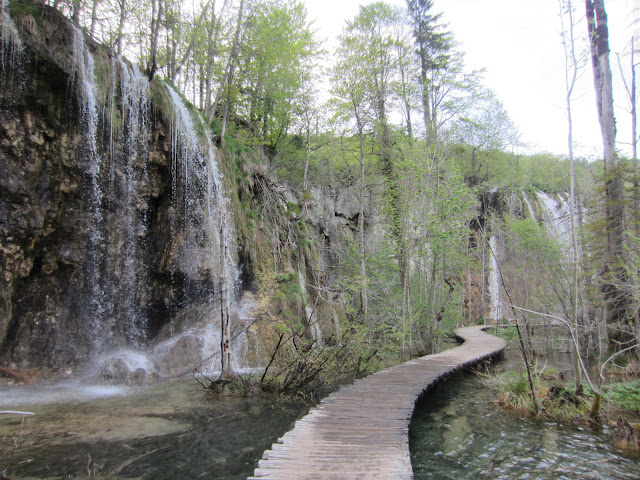 |
| Plitvice Lakes National Park (Nacionalni park PlitviДЌka jezera) |
We got wet every now and then where the paths were too close to the waterfalls. It took us a couple of hours to get down with plenty of stops to take photos. We reached a small dock where a boat took us back. There was an option to continue to the lower part of the park but it was late and we skipped that. If you decide to see the whole thing, you can choose route F which climbs up from the lowest to the highest lake.
Just before we went on the walk we bumped into my friend - the one who inspired that trip. Funny thing how this was the only place we saw each other (and by accident) when we were in at least three other cities at the same time.
Right after we got off the boat, as if we weren't wet enough from the waterfalls, it started drizzling. This time though, we managed to escape in the car and headed to our next destination.
Split. The place I loved most in the whole trip. It's a small town on the Adriatic Sea shore and it's centered around a palace. Yes, an actual palace. And the best part - our room for the night was on the inside of its walls. To get a better idea, here's a photo we found of how it used to look in the old days:
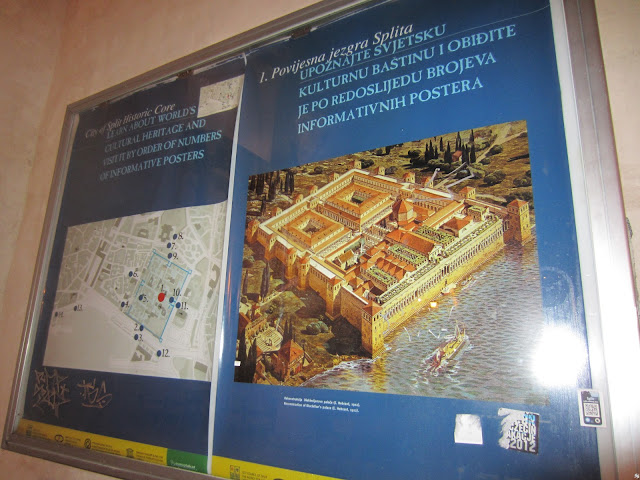 |
| Palace of the Emperor Diocletian |
Diocletian's Palace (Dioklecijanova palaДЌa) dates from the 4th century. The four walls are preserved and on the inside narrow streets stretch from one end to another. And our room was literally on the street.
| Our room in Split |
But I guess, that's not something uncommon there. Everything is on the street. Imagine what happens on laundry day. Okay, no need to imagine, just take a look:
| Laundry in Split |
The only way to get in or out of the palace is through one of the four doors in the center of each wall.
| The Golden Gate (Porta aurea) - north |
On the outside of the eastern gate - the Silver Gate (Porta argentea), there's a market where fresh fruits and vegetables can be found every day. Enter through the gate and you're at a monumental court, called the Peristyle.
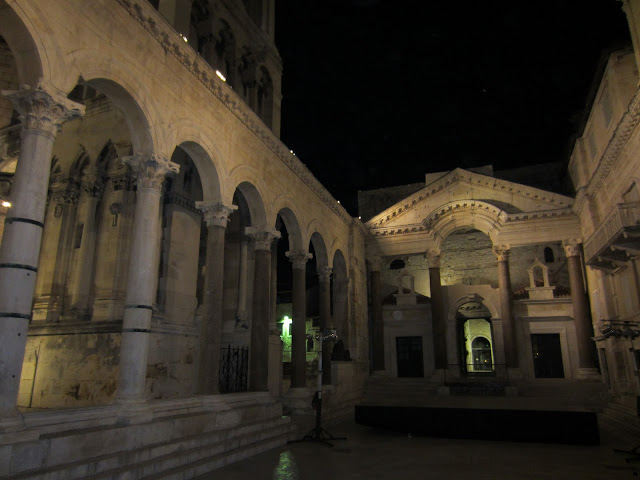 |
| Peristyle |
That used to be the main square unitl People's Square stole its glory. During the day, there's a cafe that offers a pillow along with the beverages, to sit on the stairs around.
On the left, the Cathedral of Saint Domnius (Katedrala Svetog Duje) rises.
| Cathedral of Saint Domnius (Katedrala Svetog Duje) |
It's a catholic cathedral, complex of a church and a bell tower. The church is dedicated to Virgin Mary (and is mainly a mausoleum - on the left), and the bell tower - to Saint Duje (which is also the local name of the cathedral). Together, the two form the Cathedral of Saint Domnius and it's the oldest cathedral in the world.
We went up the bell tower where beautiful views stretched before our eyes.
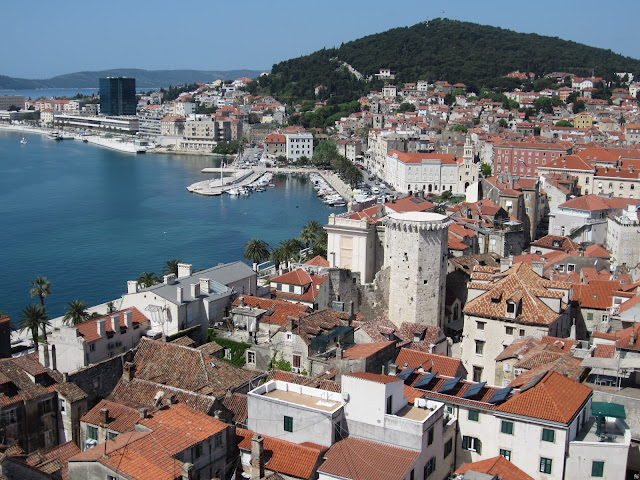 |
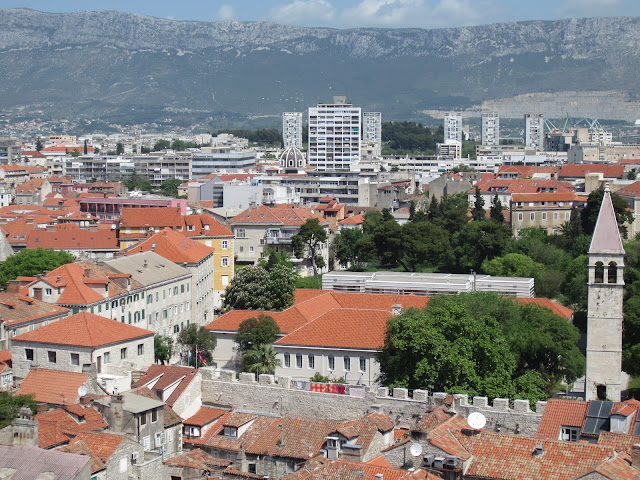 |
| Split, view from Saint Duje bell tower |
Once down, I read the press...
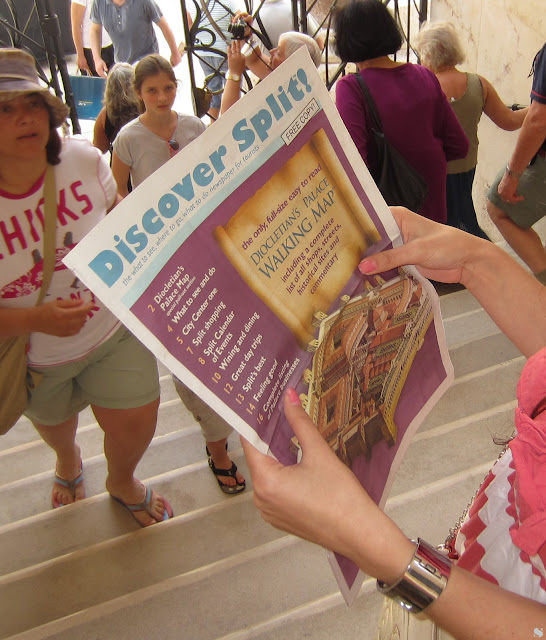 |
| Discover Split |
... (while having a nice cup of coffee in a cute cafe on one of the narrow streets inside the palace) and went on discovering Split.
Speaking of drinking, tap water is good there.
On the west, the Iron Gate (Porta ferrea) is right under a clock tower:
| Clock Tower above Iron Gate (Porta ferrea) |
Outside the gate lays the above mentioned People's Square (Narodni trg).
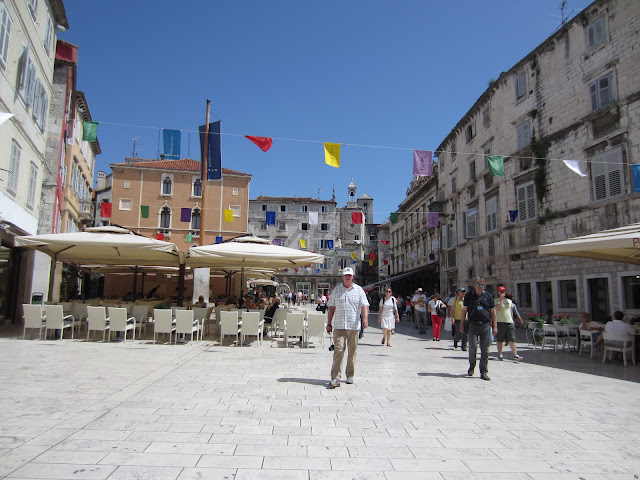 |
| People's Square (Narodni trg) |
And the main street...
 |
| Split Main Street |
... which leads to the sea.
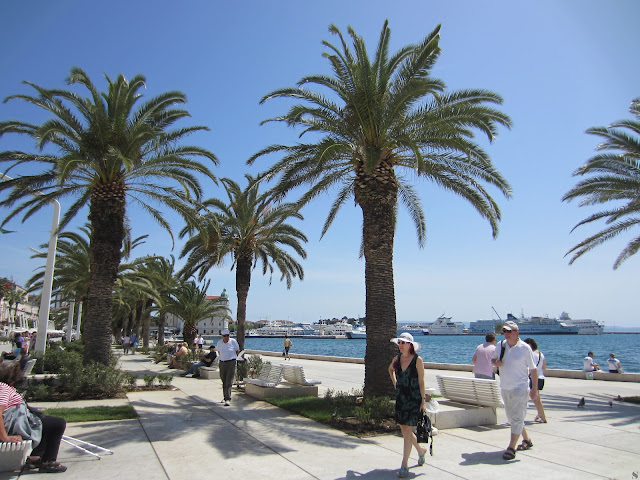 |
| Split |
There was no beach, just a shore street and the port. To reach the closest beach, we had to take a bus, but we skipped that and sat here for a while.
Of course, we didn't miss the theatre:
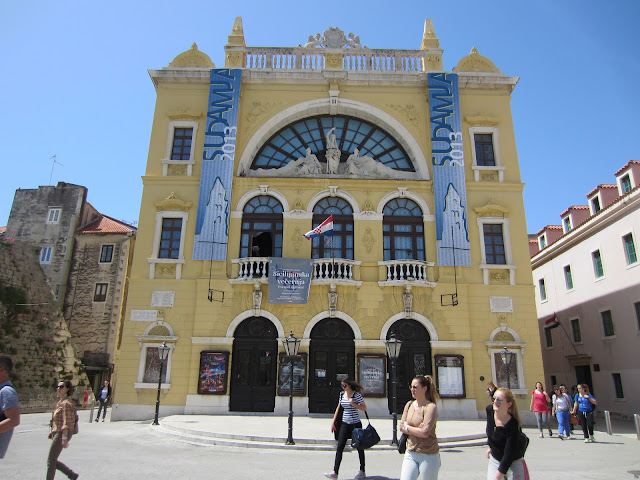 |
| Croatian National Theatre in Split (Hrvatsko narodno kazaliЕЎte u Splitu) |
The palms, the sea, the unique city center in the form of a palace made Split so charming that I didn't want to leave. But Dubrovnik was waiting.
We decided to take the ferry instead of driving through Bosnia and Herzegovina so we headed to PloДЌe, where the ferribot to Trpanj leaves from. We didn't take the highway but the coastal road.
 |
 |
| Somewhere between Dubrovnik & PloДЌe |
It took us an extra hour but it was one hour invested in beautiful sea views.
In PloДЌe, we spent our time at the docks, waiting. We thought about comitting a crime in order to avoid waiting and take a lift with the police yaht parked there...
 |
| A police yaht at PloДЌe's dock |
... but then again we weren't in such a hurry.
To my delight, the sun set at the right hour - when we were on the ferry.
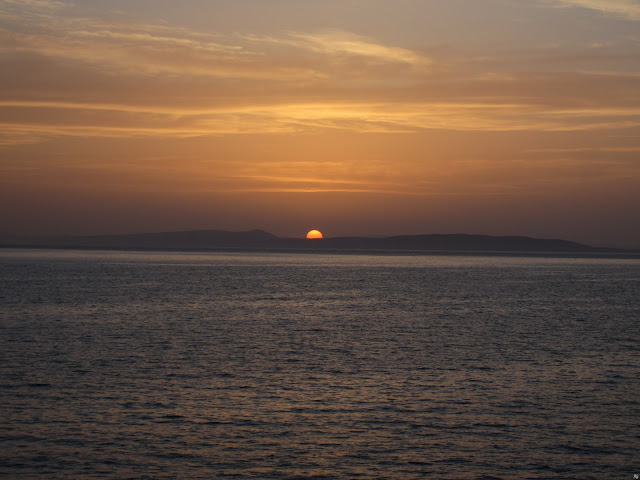 |
| Sunset in the Adriatic |
You know how much I love beautiful sunsets (and I do have 15 more photos of it but I'll spare you).
An hour later we were in Trpanj from where we headed straight to Dubrovnik. It was already dark, when we arrived and it took us quite a while to find a place to park and when we did, it was a kilometer away from the town gate. Unlike Split, you could really tell that Dubrovnik is a popular tourist destination, which honestly took a little from its charm but it was still beautiful.
Again, the main attraction was the Old City (Stari Grad), surrounded by the City Walls. And again, our studio was huddled inside the walls some steps above the main street.
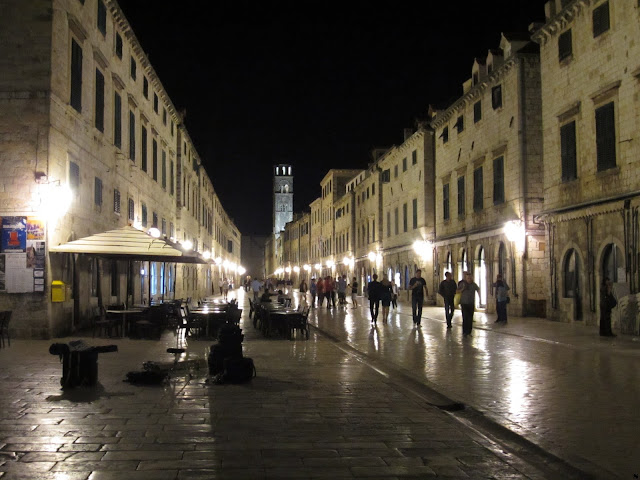 |
| Stradun - Dubrovnik's main street |
Lots of tourists were outside, on the street and in the bars. Some street musicians were playing on Luza Square (in the middle of which I'm standing to take that photo above) and had people gathered around, right next to the Church of St. Blaise:
 |
| The Church of St. Blaise |
On the following day we witnessed a wedding there. The bride nad groom had just said yes and came outside and started dancing at the church's gate - probably part of their tradition. They made a show for both the guests and tourists.
On the other side of the square, right next to one of the city gates (Gate of PloДЌa) is the Clock Tower:
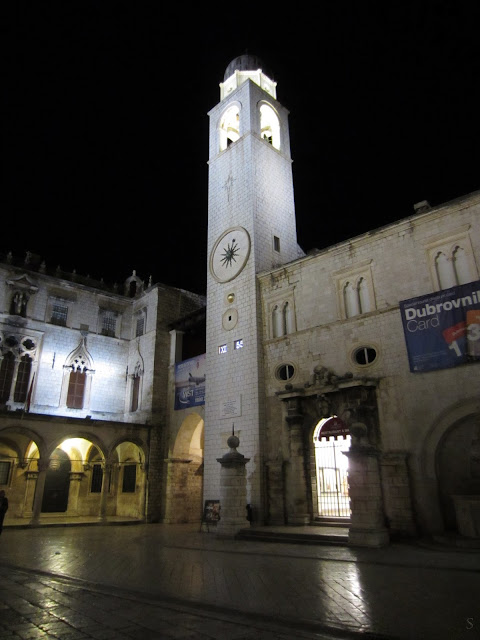 |
| The Clock Tower |
We continued our walk toward the Sponza Palace which today houses the City Museum.
| Sponza Palace |
They used to store gunpowder inside and it has exploded two times in the past.
We climbed up some stairs to find St Ignatius’ Church (Crkva sv. Ignacija):
 |
| St Ignatius’ Church (Crkva sv. Ignacija) |
There were three or four cats at that square and later we noticed that cats were everywhere in Dubrovnik. The explanation was simple: in the long war between cats and dogs, cats had prevailed and the city had fallen under their government so they'd forced all the dogs outside its walls, in the countryside. I mean, could there be a more logical explanation?
The Cathedral:
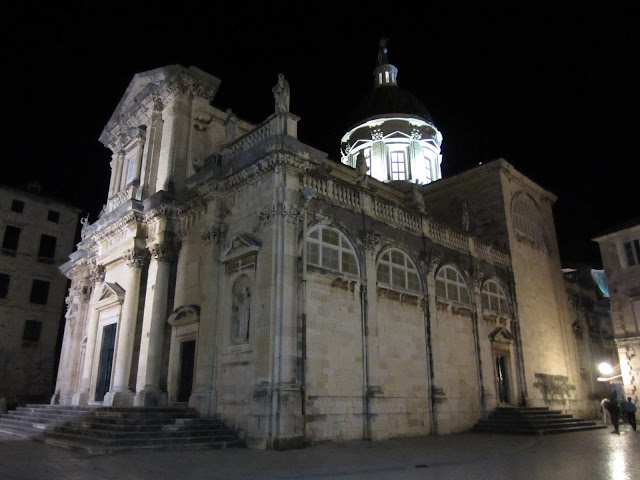 |
| Assumption Cathedral (Katedrala Velike Gospe, Katedrala Marijina Uznesenja) |
We soon reached the other end, where a second gate lets you in and out of the Old City - Pile Gate:
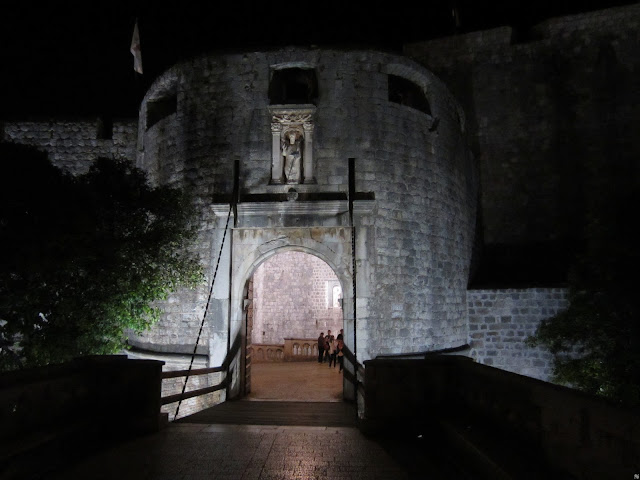 |
| Pile Gate |
That wooden bridge used to be pulled up every evening. I tried but I hadn't had my spinach so...
Speaking of food, they had these very easy-to-carry french fries:
... which we ate at a beach on the next evening, but I'll get there.
We spent the rest of our evening at a children's playground just outside the city walls. Don't judge! There were swings!
On the following day, we did what every other tourist does. We spent our last kuni on souveniers. But before that, we went for a walk on the City Walls.
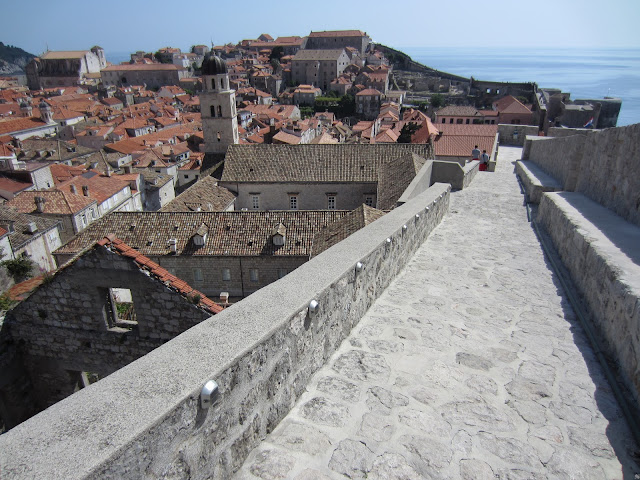 |
| City Walls |
The walls surround the Old City and served as protection of the Dubrovnik Republik in the past. They are among the most complete in Europe and are almost 2 km long, which should take and hour or so to go round. It took us 3. Hence, the 1246 photos. And the sunburn. The sunscreen which didn't see the outside of our luggage could have come in handy.
The views were pretty great, though:
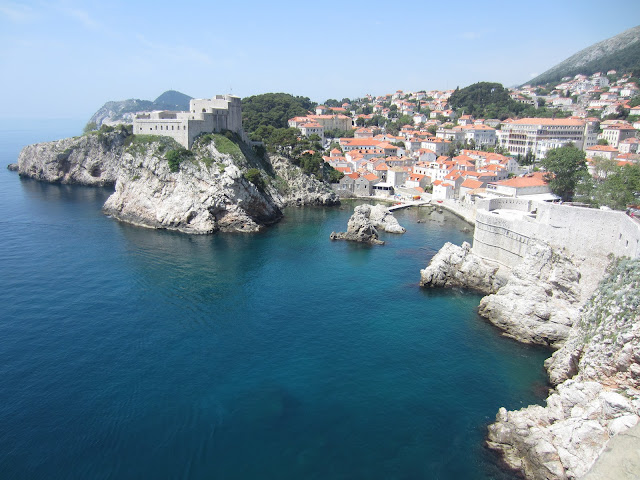 |
| Adriatic Sea and Fortress MINДЊETA on the left |
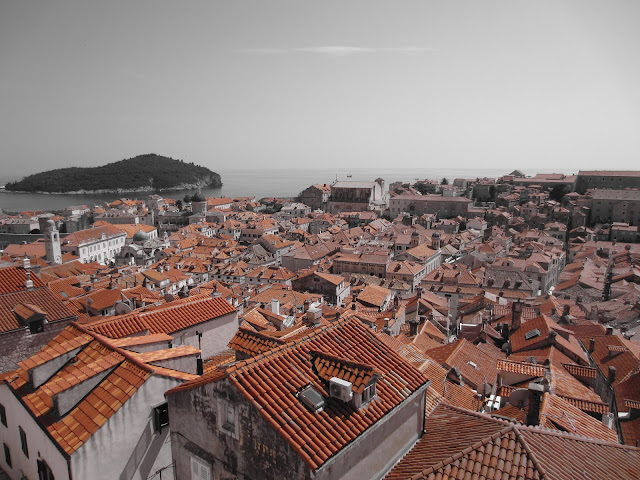 |
| Duvrovnik, view from the City Walls |
Most of the sights we had already seen were visible from above. Just at a different angle.
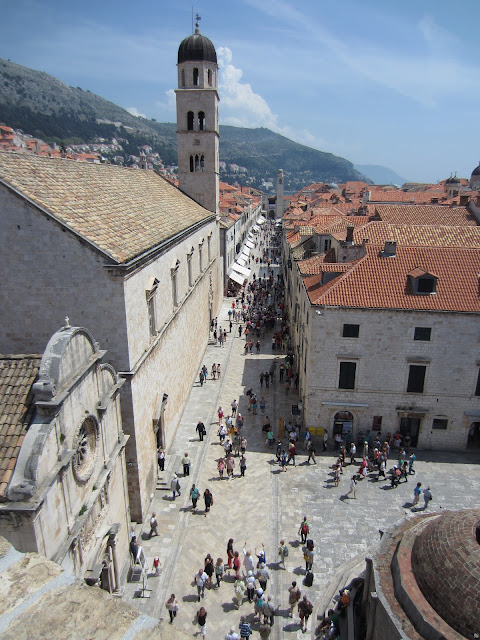 |
| The Church of the Holy Savior on the left, Stradun, part of Big Onofrio's Fountain on the right |
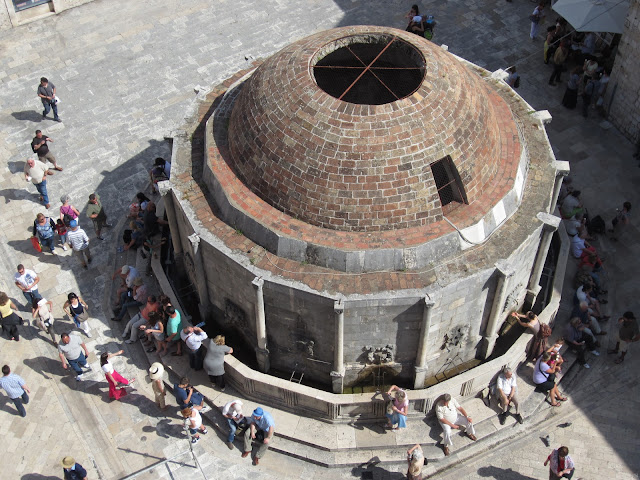 |
| Big Onofrio's Fountine |
Big Onofrio's Fountine with all of it's 16 sides is part of the town's water supply and the well it takes water from is 20 km away.
However, you can see more than sights from above. There were schools and playgrounds... The walls were even part of some house roofs and there were front doors exiting on them.
There was this Indian family we walked with almost all the way around. They were very engaging. The little girl found some shade and said 'Mom, I'm going to stay in the shade. I might even sit.' She was cute.
The Old Port:
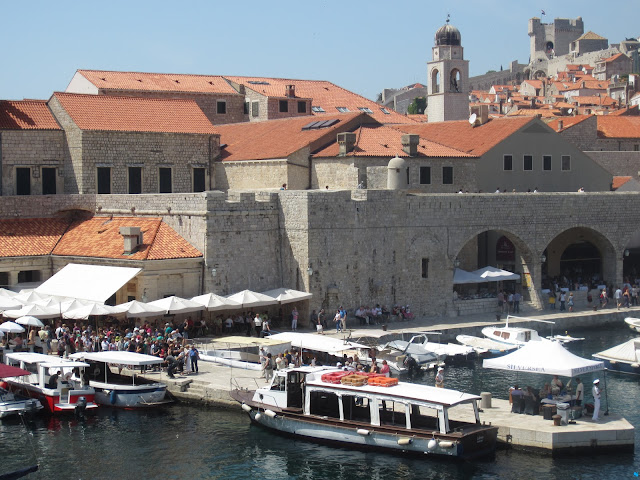 |
| The Old Port |
There were these glass boats, where part of the bottom is a see-through glass. My friend, the one we bumped into at the lakes, said they'd taken one and what they saw was (pause for a dramatic effect) water. No mermaids (sigh).
Also, there were a couple of cruise ships which berthed there on both days (I guess it's a daily thing) and they were trasnporting the passengers to the port with these boats that said they could fit 117 people tenderly but a maximum of 150. 33 more and there goes the tenderness.
We saw something that we particularly liked while circling the city:
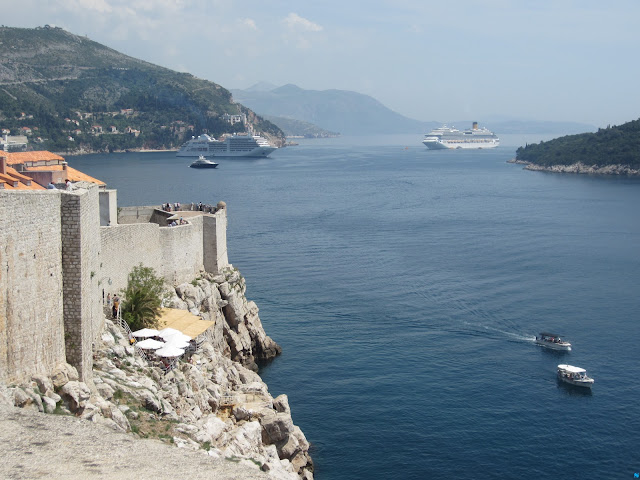 |
| Dubrovnik City Walls |
See those umbrellas there? That's where we spent the rest of our afternoon...
 |
| In Dubrovnik |
... having a glass of tonic on the rocks (pun intended) in the company of one of the city rulers:
 |
| One of Dubrovnik's many cats |
There was a fisherwoman there, who seemed to be catching dinner and the first fish she caught, that cat, after stretching all afternoon on the warm rocks sneaked under her legs and stole.
There weren't only glass boats and cruise ships out there:
To Neverland?
Probably a good time to visit Dubrovnik would be between July 25th and August 10th. There's the Dubrovnik Summer Festival then with a rich programme of classical music, theatre, opera and dance performance.
We didn't get to enjoy those but we spent the evening at a small beach just outside Pile Gate. There was a party going on on the other side but we had those french fries I mentioned above. It was a tough choice but in the end we stuck with the fries.
One thing I forgot to do was take a photo with a T-shirt I'd specifically bought for the trip. It said Croatia on it and it never came out of my suitcase. I know. We, girls, overpack.
On the next morning we drove off to Montenegro. It took us some time to cross the border but once on the other side, we took the long route to Kotor - the one that circles around the Bay of Kotor (Boka Kotorska).
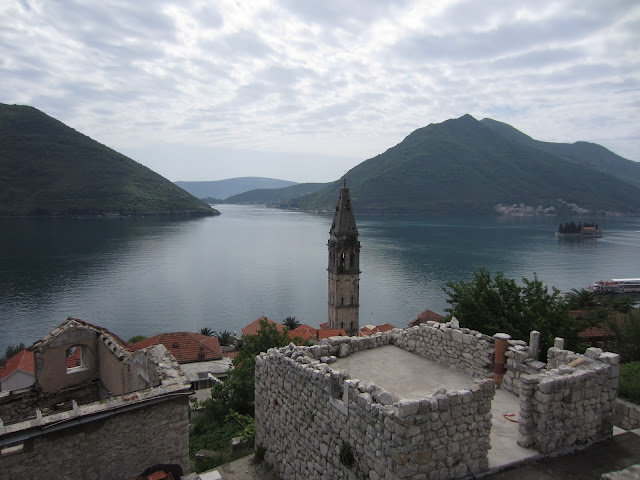 |
| Bay of Kotor (and Dobrota) |
No regrets there. It was quite beautiful with a couple of islands with churches on them (the islands of Saint-George and Our-Lady-of-the-Reef) in the middle.
We reached Kotor, where another old town awaited.
Right across the main entrance - Sea Gate:
| Sea Gate |
was the town Clock Tower:
An earthquake in the 17th century tilted it but it was rebuilt after. (Could have been the second Piza!)
Narrow coble-stone streets, lots of cafes and plenty of spiritual places:
 |
| Cathedral of Saint Tryphon (Katedrala Svetog Tripuna/Катедрала Светог Трипуна) |
 |
| Church of St. Nicolas |
 |
| Saint Lucas's Church |
In the spirit of old towns, some ruins:
| Kotor |
And cats!
But the most impressive part of Kotor were its fortification walls:
 |
| Fortifications of Kotor and Church of Our Lady of Health on the left |
4.5 km long, 2 to 16 m thick, and a height up to 20 m. We skipped that climb since the traces from our previous one were still red on our skins. Though, I'm sure the view must be great. One thing we noticed: one of the languages which the ticket prices were written in was Bulgarian.
The official language in Montenegro is Montenegrin, which is a Serbo-Croatian dialect. Historically, it was Serbian. According to statistics, almost half of the citizens of Montenegro say they speak Serbian.
But back to Kotor. The whole town was built with protection in mind so even the streets inside could be confusing. It's pretty small so there's a slim chance you'll get lost but you may not always be aware of your exact location.
I'd read about squares with funny names, like Milk Square or Flour Square. We didn't find those but good luck to you!
Our last night we spent in Budva. Can you guess what the main sight was? Let me help. Starts with Old and ends with Town.
 |
| Budva - Old Town |
It was officially the trip of Old Towns.
And what's an Old Town without a church?
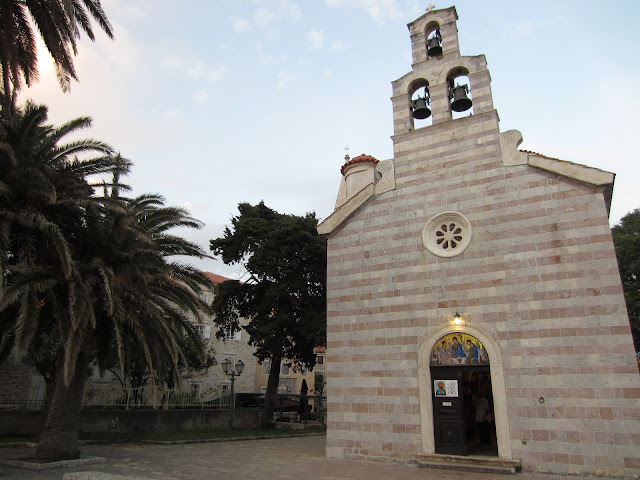 |
| Holy Trinity Church |
| Church of Saint John |
That last photo is from our walk on the city walls. Notice anything? More cats!
If you want to know how a Montenegrin's day goes by, just peek through the windows of their living room.
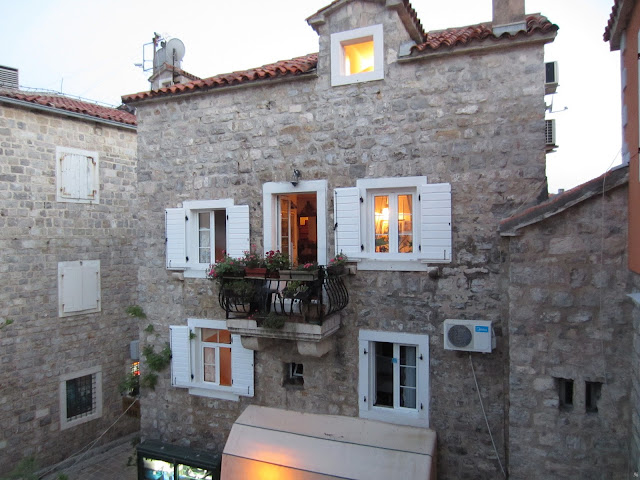 |
| Budva |
Though, not all were so open to it. We saw a window looking straight at the wall. Quite a stoney view.
The port...
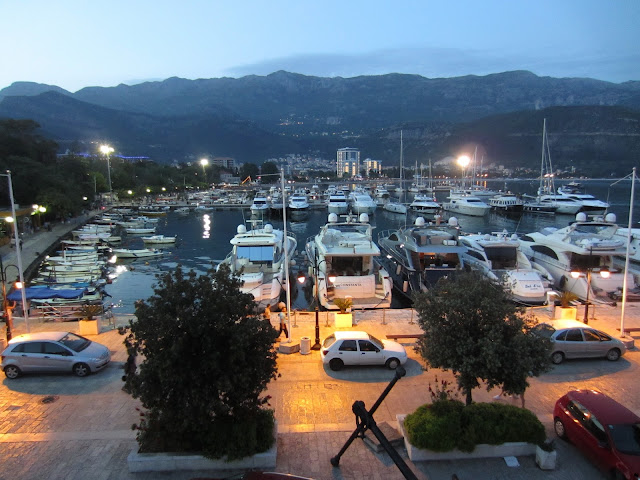 |
| Budva port |
... where I'll anchor my yaht next time I visit. Given, I'd married Brad Pitt (who recently bought one for 5 million) by then. Oh, I'm open to other yaht-owner candidates as well.
Turns out that Budva is famous for its beaches (Budva Riviera (Budvanska Rivijera)):
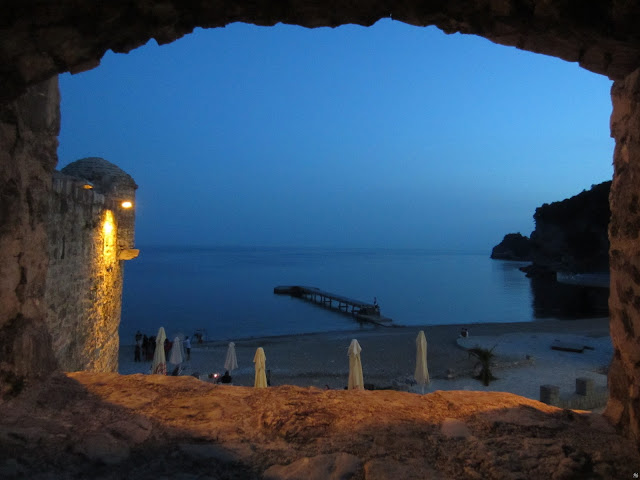 |
| Budva |
My impression of those beaches was that they're mostly rocky, even the sandy ones. The sand was more like gravel, though more fine.
I only got to dip my feet in the Adratic and have a refreshing drink in a beach cafe which put a nice end to the trip.
Or at least the sightseeing part of it. The last day we spent on the road. As soon as we left Budva, the altitude changed from 0 to well, I didn't have a meter on me, but it was drastic.
 |
| Montenegro |
There's a reason for the country to be called Montenegro, meaning "black mountain". Most of its territory is taken by mountains.
We made a stop at Podgorica - the capital, where we didn't see much worth writing about. A tower, a bridge and a fountain. There was supposed to be a palace but we only came across some fence. I suppose there are more things to see there, but we weren't prepared and counted on our intuition so that was it.
 |
| Podgorica |
More info about Montenegro: they use Euro as their official currency even though they're not in the European Union. They honour the orthodox holidays so when we arrived it was actually Easter there. As in Beograd - no parking fees.
We soon continued on our way. The main road back to Serbia drives by river Lim.
 |
| r. Lim |
This is its original color. No photoshop effects. It looks like those heavenly photos of islands in the middle of nowhere where everyone dreams of going one day.
The river promised a curvy road. But not as curvy as the one we took. As we were driving, a long line of immobile vehicles suddenly appeared. There were some repair works at a tunnel ahead and we had to wait for two hours in order to continue. The GPS had tried to trick us into taking a turn earlier which we missed because it didn't seem like the main road. (It wasn't.) But with the new circumstances we changed our minds and went back. Big mistake. It was a really narrow road (barely fitting two cars) up and down the mountain with no barriers on the sides, just steep deep chasm.
 |
| Montenegro |
To top that, a thunder storm caught up with us. We were in a scary movie.
I was so releived and relaxed when we reached the main road that I fell asleep. Only to find out this when I woke up:
A TIR right in front of us! Thankfully, it wasn't moving towards us. Another truck was pulling it.
The last mishap was when we were about to take the highway in Serbia and we took it in the wrong direction. We blame the sign, of course. So an extra 12 kilometers.
In the end, around 2 am, we reached home safe, sound and with a bunch of memories that I just poured out here. So let's not make this one of those stories that start over at the end and continue forever. The end.
